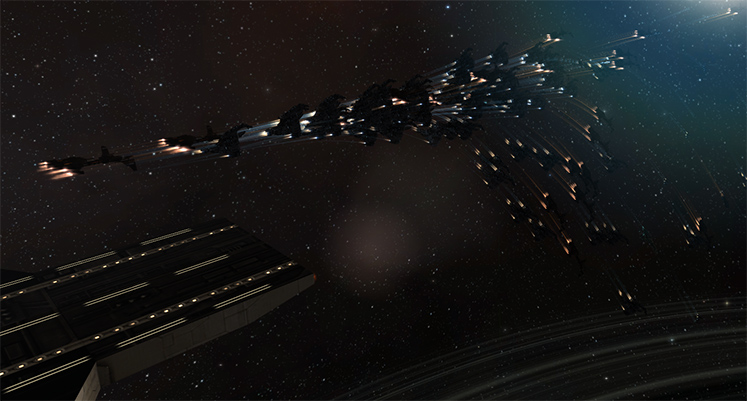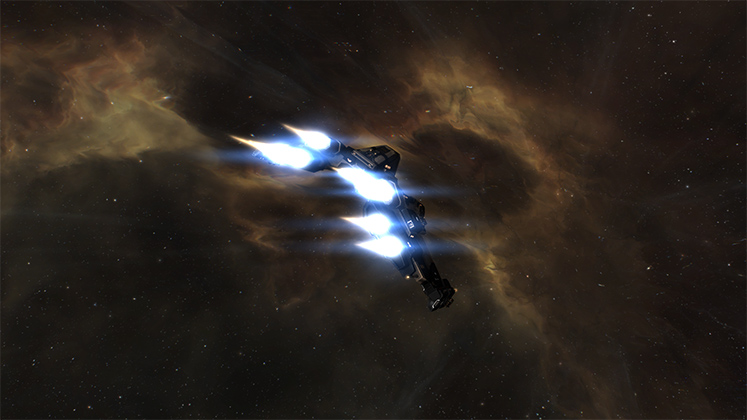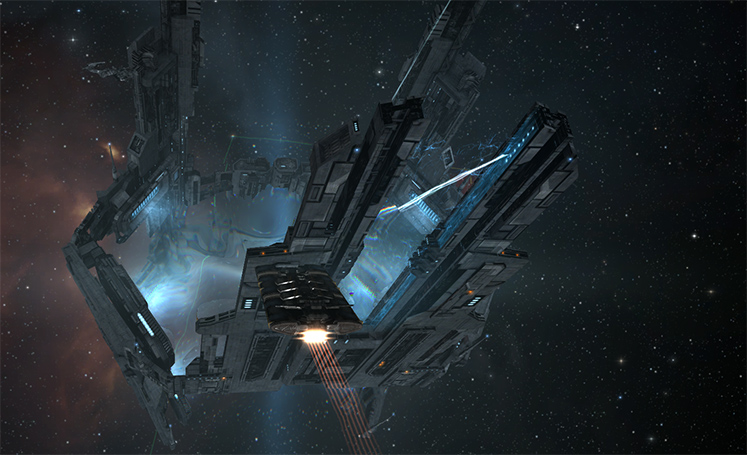History
Your Skills
Navigating the EVE universe
The Map
Death
EVE's Ship Sizes
The Downtime
Fitting Basics
Tanking Basics
▼ EVE's Factions ▼
The Amarr Empire
The Caldari State
The Gallente Federation
The Minmatar Republic
▼ First Guides ▼
The Hacking Miningame
Missiles (Basics)
Turrets (Basics)
Drones (Basics)
Implants and Attributes
4 Starter PvE Fits
4 Starter PvP Fits
navigating the game world
EVE Online is big, very big. If a sole server is able to hold the EVE Online gamer population of the entire world (minus China), it is bound to have enough room for all these individuals ;).
EVE has 8031 solar systems. Each of these solar systems is composed of Planets, Moons, Asteroid belts, Stations, Stargates, player-built Citadels, and random "spots" of mission, mining, exploration... and of course, wormholes.
By this point hopyfully, you realize how big that is.
Conventional engines
First method to move around, the regular, old-fashionned engines. Double click in some direction in space, and the ship will start to move toward that direction, using its engines.
The conventional engines are idea to move over short distances of less than 150km (technically, half that if you know where you are going right from the start).
Solar systems are big. Their size varies from 20 to about 340 AU. 1 AU = The distance earth-sun, wich is about 150 000 000 km. Light takes about 8 minutes to travel that distance, so even going at the speed of light, that's only 0.0002AU/sec. Could you imagine traveling 340AU at that speed? That would not be practical!

A fleet of ships using their regular engines
commands related to regular engines
Approach: Move toward the entityyou issued the approach command on, and adjust your alignment to take into account any movement of that object.
Align to: If the "Approach" command isn't available, it's the "Align To" option that you will see in its place. "Align To" is basically "Approach" for entities you will NOT be able to reach without a warp, due to their distance.
Keep at range: Enables you to keep a specific range (with a substantial margin of error in some cases) with the entity you issued the command on. If the entity moves, your ship will also move accordingly, but will NOT try to anticipate any movement, and read the velocity vector of the targeted entity instead of the lone distance between the entity and yout ship.
Orbit: Orbit is just like keep at range, but the ship will stay in constant motion around the targeted entity.
The technical term for using the regular engines to move around, is to "Slowboat".
Warp drive
That's where the warp drive comes in handy. A techology equipped on every flyable ship in-game that enables the ship to generate anti-friction to accelerate in the void way beyond light speed. In EVE, ships can go from 1.35 to about 30 AU/sec, which is already more bearable. The actual warp duration is however longer than a simple division distance over speed, as there is a acceleration and deceleration speed relative to the maximum warp speed. Note that the deceleration is capped at a rate that is equal to the deceleration of a 6 AU/sec ship. It's still better than 0.0002 AU/sec though.

A interceptor-class Raptor ship, mid-warp. Note the distortion effects.
How does the warp drive works?
Once you have issued the Warp To command, the ship will "align" toward the direction of the entity you are about to warp to. In EVE, to align is to keep moving in the right direction at more than 75% of your maximum speed. The visual orientation of the ship will not influence your time to enter warp.
Once the ship reaches 75% of the maximum speed in the right direction, it will enter warp. You can also select the "align to" command to align the ship without issuing a warp command, to be able to enter warp immediately whenever you want, because you are already aligned (which is the condition to enter warp).
During the warp, you will lose te control of your ship.
The "Stop Ship" command (Shortcut CTRL + SPACE) enables you to cancel all issued orders to the ship. This enables you to cancel the pre-warp alignment that precedes a warp, if you change your mind.
The Warp Drive will use your capacitor (the energy of your ship) to warp, right as you issue the warp command. if all of your capacitor (or cap) is consumed, your ship will only make a partial warp with what it was able to get, which will require you to make a second warp to dothe rest of the distance. Your capacitor will regenerate during the warp, so hopefully you won't have to do more than two partial warps to reach your destination.
Where can you warp to
You can only warp to pre-existing space objects (called "Celestials"), and scanner (or combat, for pvp) probe results. You cannot warp to an arbitrary direction for an arbitrary distance. Therefore, most things will appear inside the flat circle of a solar system, near a celestial... And not in the middle of nowhere!
Stargates
But even the warp drive and its maximum speed of about 30AU/sec will not be enough to cover the light years worth of empty space between two solar systems. That's where Stargates come into play. Using the "Jump" command while being at less than 2 500m from it, will enable you to activate it and change your current solar system.

A big Orca ending its warp near a Caldari Regional Stargate (one of the biggest ones)
The size and shape of the game's Stargates depends on the type of link between the two systems it connects. Smallest stargates are used to move within a constellation of solar systems, while medium stargate are used to move between two different constellations. Large stargates are of course used to move between different regions. This doesn't always indicates that the length of the jump on the map will be longer though.
You will reappear in the new system at 15km from the stargate in a random direction. This means that you will need to travel 12.5km with your regular engines if you want to "crash the gate" (an EVE term to indicate that you go back to where you came from, using a stargate). This is something worth keeping in mind if you intend to travel in potentially hostile space.
The bigger the stargate, the larger the possible "spawn" zone, and therefore the harder it will be for hostile players to reach a 100% coverage while "gate-camping".
Using a stargate will leave your ship invisible for 60 seconds after the jump. This invisibility will immediately stop if you issue a movement command, despite the fact that the animation visually takes a few seconds.
Also includes Wormholes, a special kind of "temporary" stargates with their own rules, destination, and entrance.




